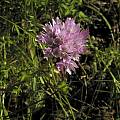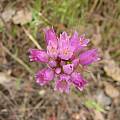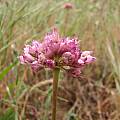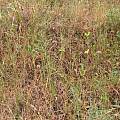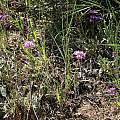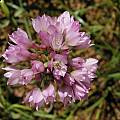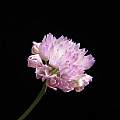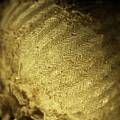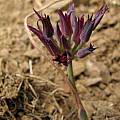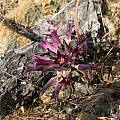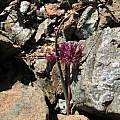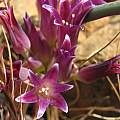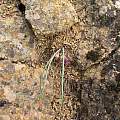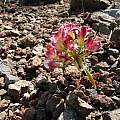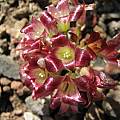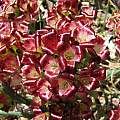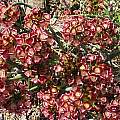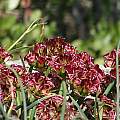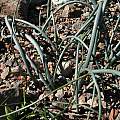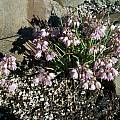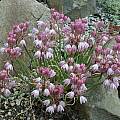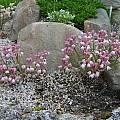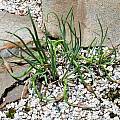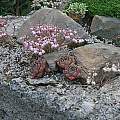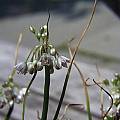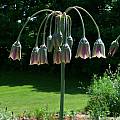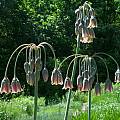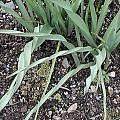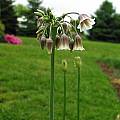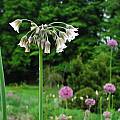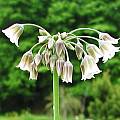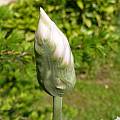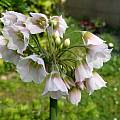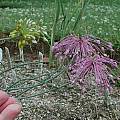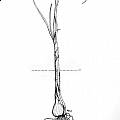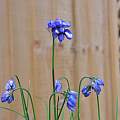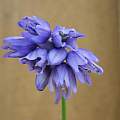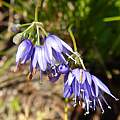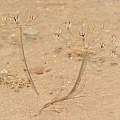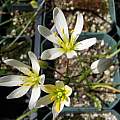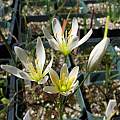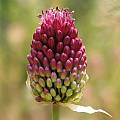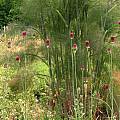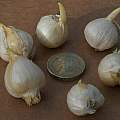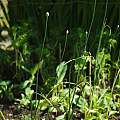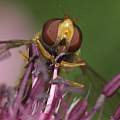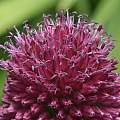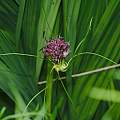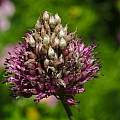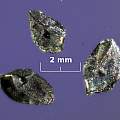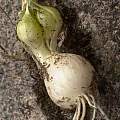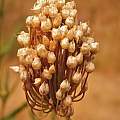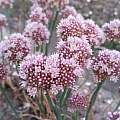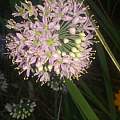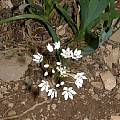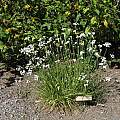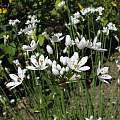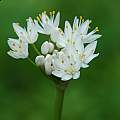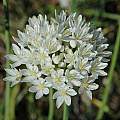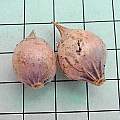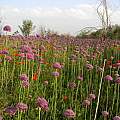This page compiles all the information and photos of the Allium taxa, cultivars, and hybrids we currently have on the PBS wiki. The Allium index gives information about the genus and includes tables of species and hybrids and cultivars.
Page 1: A. Globemaster... Page 2: A. atropurpureum... Page 3: A. carmeli... Page 4: A. decipiens... Page 5: A. guttatum... Page 6: A. karataviense... Page 7: A. membranaceum... Page 8: A. paradoxum... Page 9: A. regelii... Page 11: A. tardiflorum... Page 12: A. vineale...
Allium serra McNeal & Ownbey is from the central coast ranges of California, found in grassy slopes, often under blue oaks (Quercus douglasii Hook. & Arn.), blooming from March to May. It has pink flowers which become more papery as they age. Photo 1 from Mary Sue Ittner shows an inflorescence blooming April 2005 in Bear Valley in Colusa County, California. Photos 2-5 from Nhu Nguyen show plants in habitat near Mt. Hamilton, Santa Clara County, California.
The photos below are of plants in cultivation. Photo 1 was taken by Mary Sue Ittner. Photos 2-3 were taken by Nhu Nguyen. Photo 3 shows the bulb scale's beautiful "herring bone" pattern. This character is very important in identifying this and several other related species.
Allium sharsmithiae (Ownbey & Aase ex Traub)McNeal is a small onion restricted to the Mt. Hamilton Range in central California. It occurs only on serpentine soil. The leaves will often die down before the flowers bloom. Photos by Nhu Nguyen taken in habitat. The last photo shows a typical talus slope habitat for this species. Look to the lower right hand corner and you can make out pink patches that are these plants.
Allium shevockii McNeal is also another small but beautiful onion with a large inflorescence of dark red petals. It is found only on Spanish Needle Peak area in Kern County, California where it grows on metamorphic outcrops or talus. It was first collected by Jim Shevock, for whom the species was named. Photos by Nhu Nguyen at the Tilden Botanic Garden. The last photo shows the glaucous and thick succulent leaves and buds.
Allium sibthorpianum Schult. & Schult.f. is a gem among many fantastic species native to Turkey. It's a tiny, clustering, rock garden sort that's ideal in troughs, well drained containers, or sand beds out in the garden. The key here is excellent drainage. This species looks something like Allium flavum ssp. tauricum (Besser ex Rehb.)K.Richt. and A. paniculatum L. in the shape and disposition of the little dangled bell florets, and several other diagnostic characteristics shared by this group of allied species. The flowers appear in June, the clusters of silvery pink bells are held atop chunky stems only 2"-3" (5-8 cm). As the flowers age, the florets deepen to a raspberry rose color and turn upright. I believe that this species hybridizes with Allium flavum ssp. tauricum, giving rise to dwarf, earlier flowering progeny. In the bud stage, it's intriguing how the buds appear as contorted prostrate snakes! In the final view of Alliums growing in a trough, we see Allium sibthorpianum and a couple of pale-flowered forms of Allium flavum ssp. tauricum. Photos 1-5 by Mark McDonough. Photo #6 was taken by Arnold Trachtenberg of a pot grown from NARGS seed in 2000.
Allium siculum Ucria (syn. Nectaroscordum siculum (Ucria) Lindl.) is often confused with a very similar species A. bulgaricum (Janka)Prodan. In cultivation it is reported that whatever distinction these two species have, they integrate readily, and most bulbs or plants offered for sale are hybrids between the two. At any rate, these are intriguing, easy-to-grow plants, well worth cultivating. The large, waxy, bell-shaped flowers are produced in May to early June atop 3' (1 meter) stems, the florets suspended on long drooping pedicels, adding to the charm of the quaintly hued blooms. Here are 3 views of this unusual plant. Notice in the 3rd photo, that the foliage is instantly recognizable, being triangular in cross-section and strongly twisting along the length of the ascending leaves, as if sculpted of wrought iron. Photos by Mark McDonough.
Allium siculum ssp. disoscoridis (Sm.)K.Richt. (syn. Nectaroscordum meliophilum (Juz.)Stank.) from the Saint Petersburg Botanic Garden, said to have originally been from Crimea. The outside of the tepals are dark brownish-olive-rose color with white flared tips, eventually opening into lovely white bells softly tinged olive and dull rose on the outside. Some flowers have 7-8 tepals instead of the normal 6. It is 24" (60 cm) tall in bloom. The first three photos were taken by Mark McDonough, taken May 25, 2003 showing order of flower development. The last two photos were taken by Alessandro Marinello.
Allium sieheanum Hausskn. ex Kollmann is a dwarf Turkish species that resembles a miniature version of Allium carinatum ssp. pulchellum (Regel)Bonnier & Layens, with procumbent wiry stems, and numerous tiny rose purple flowers suspended on very long pedicels of the same intense rose color. Blooms in June-July. Photo by Mark McDonough. The second image is a black and white drawing from Mark McDonough. It illustrates a form from Turkey, originally from the MacPhail and Watson expedition back in the 1970s; the heads of bloom varied from loose and open, to tight and globular. The drawing shows the beautiful form with tight, globular heads of blue-purple floret.
Allium sikkimense Baker (syn. Allium cyaneum var. brachystemon Regel, Allium kansuense Regel, Allium tibeticum Rendle) is an Asian species native to Tibet, China, and into India, closely allied to A. beesianum W.W.Sm. Striking blue flowers with hooded nectaries top 5 to 40 cm scapes. The bulbs are clustered and cylindrical, with dark brown tunics, reticulated at the base. Grows in forest margins, scrub, slopes, and meadows from 2400-5000 m. See a full description on the Flora of China of Allium sikkimense. Photos 1 and 2 by RH of plants grown from AGS seed. Photo 3 by Kathleen Sayce.
Allium sindjarense Boiss. & Hausskn. ex Regel is a Middle Eastern species of wild onion found in Israel, Palestine, Iraq, Kuwait, Turkey, Lebanon and Saudi Arabia. It has very tiny white flowers on elongated pedicels. Photo by Gideon Pisanty.
Allium sp. Seeds of this undetermined species was collected in Chiapas, Mexico. It is a nice little plant that grows and blooms well in a 10 cm (4 inch) pot. It is a summer grower and needs a dry winter dormancy. It takes 3 years to flower this plant from seeds.
Allium sphaerocephalon L. syn. Allium sphearocephalum, also called "round headed garlic" (sphaero = sphere, cephalum = related to the head) is an easy to grow onion that produces very dramatic flowering heads in early summer. It is grown in many climatic regions in the United States including the Deep South. It is frost hardy, drought tolerant, best grown in full sun and well drained, fertile soil with extra lime. The species can be propagated vegetatively by bulbs and bulbils. A single bulb produces about 4 bulbils at the end of the growing season in early summer. The first two photos below were taken by Nhu Nguyen; the remaining photos were taken by David Pilling (the coin is about an inch in diameter). The last shows that the flowers do not open widely when the style and stamens appear.
Photo 1 shows a flower that was covered by foliage from nearby plants, and produced bulbils instead of a full flower. Photo 2 shows pollinated flowers forming seed pods. Photo 3 is of seed. Photo 4 is of a bulb accidentally uprooted whilst still growing, showing bulblet formation just below the surface (the stem is visible to the top left).
Photo below of the ripening seed pods by Travis Owen.
Allium staticiforme Sm. (syn. Allium urvillei Heldr. & Sart.) is native to Greece and western Turkey. The plant produces a tight umbel just 1.5-2 cm across and a stem rarely over 20 cm tall. Different color forms are available ranging from pink to white. Not a very cold hardy species. Photo by Wietse Mellema.
Allium stellatum Ker-Gawler is distributed from central Canada through the central part of the United States. It is commonly known as "prairie onion". It blooms from August into October with 2 to 3 inch (5-7.6 cm) heads of whitish to lavender florets. It is native to rocky soils and grows in clumps of narrow tubular foliage 30 to 70 cm (1 to 2 feet) tall. Photo from Steve Evans of plant flowering in Oklahoma September 2018. He notes that he has never seen it much more than about 1 foot (30 cm) tall.
Allium subhirsutum L. is a Mediterranean species. It has finely ciliate (hairy) leaves, from which it gets its specific name. Photo 1 was taken from habitat by Angelo Porcelli. Photos 2-3 were taken by Nhu Nguyen at the UC Botanical Garden.
Allium subvillosum Salzm. ex Schult. & Schult.f. is a Mediterranean species flowering from March to May and growing on sandy beaches and fields from Greece to Portugal and North Africa. It is a tall species with many white flowers in a wide umbel. Photos by Mary Sue Ittner and Bob Rutemoeller. The last one shows bulbs on a 1 cm grid.
Allium suworowii Regel (sometimes wrongly spelled suworovii) is native to the Fergana Range in Uzbekistan in mountains and stony meadows. The flowers are mostly mauve, star-like, with exerted stamens. Photo by Andrey Dedov.
Page 1: A. Globemaster... Page 2: A. atropurpureum... Page 3: A. carmeli... Page 4: A. decipiens... Page 5: A. guttatum... Page 6: A. karataviense... Page 7: A. membranaceum... Page 8: A. paradoxum... Page 9: A. regelii... Page 11: A. tardiflorum... Page 12: A. vineale...
Allium index - Allium flavum Relatives - American alliums A-F - American alliums G-Z - Big Ball alliums - Blue alliums - Chives - Domed alliums - Drumstick alliums - Rhizomatous alliums
